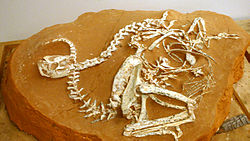- Oviraptorinae
-
Oviraptorines
Temporal range: Late Cretaceous, 84–70 Ma
Fossil skeleton of Khaan mckennai Scientific classification 
Kingdom: Animalia Phylum: Chordata Class: Reptilia Superorder: Dinosauria Order: Saurischia Suborder: Theropoda Family: †Oviraptoridae Subfamily: †Oviraptorinae
Barsbold, 1976Type species Oviraptor philoceratops
Osborn, 1924Genera Synonyms Conchoraptorinae Barsbold, 1986
Oviraptorinae ("egg thieves") is a subfamily of bird-like maniraptoran theropod dinosaurs within the clade Oviraptoridae.
Classification and species
The classification of the oviraptorids has been controversial. The Oviraptoridae was traditionally divided into the small, short-armed, and crestless subfamily "Ingeniinae" (the name was preoccupied by an invertebrate group), and the larger, crested, long-armed Oviraptorinae. However, later phylogenetic studies showed that many traditional members of the Caenagnathidae were in fact more closely related to the crested oviraptorids. Because Caenagnathus itself is no longer considered part of this group, the subfamiliy is usually now termed the Elmisaurinae. The Ingeniines are now typically included with the oviraptorines to reflect this new basic division in forms. The taxonomy below follows the one presented by Thomas Holtz, Jr. in 2010.[1]
- Oviraptorinae
- Banji long, a primitive form known from a lower jaw, pelvis and hind limb elements. Mangchuan Formation, China.
- Citipati osmolskae was named based on several well-known specimens, including nesting adults, eggs, and an embryo. It had an anteriorly-placed crest and lived at the same time and place as Oviraptor.[2] Djadochta Formation, Mongolia.
- Citipati sp., a specimen tentatively referred to the genus Citipati, was found in the 1980s and previously thought to be Oviraptor. It had a forward-sloping cassowary-like crest.[2] Djadochta Formation, Mongolia.
- Conchoraptor gracilis is a small crestless form with a slender second toe. Many specimens have been referred to it, but there have been no detailed studies showing exactly which ones are correctly referred. Barun Goyot Formation, Mongolia.
- Heyuannia huangi is the first named oviraptorid from China and resembles Ingenia closely, but is distinguished by having more hip vertebrae and the first finger fused with the wrist. Dalangshan Formation, China.
- "Ingenia" yanshini has also had a lot of material referred to it that probably doesn't belong. It was contemporaneous with Conchoraptor, and work needs to be done separating their remains from each other. "Ingenia"s hand is distinguished by a very large first finger and reduced second and third fingers. The name "Ingenia" is preoccupied and will be replaced in the near future. Barun Goyot Formation, Mongolia.
- Khaan mckennai is another taxon that closely resembles Conchoraptor, but has a reduced third finger. It lived alongside Citipati. Djadochta Formation, Mongolia.
- Machairasaurus leptonychus an "ingeniine" known only from a hand and partial arm, with weakly clawed digits indicating herbivory.[3] Barun Goyot Formation, Mongolia.
- Nemegtomaia barsboldi, originally named Nemegtia and once assigned to "Ingenia", known from excellent skull material. Nemegt Formation, Mongolia.
- Oviraptor philoceratops, from the Late Cretaceous of Mongolia. Found in 1924, it has a longer snout and seemingly extensive crest on its head. Most illustrations of it are actually based on Citipati sp.. Djadochta Formation, Mongolia.
- Rinchenia mongoliensis was originally called Oviraptor mongoliensis. It had a very high crest on the center of its head, and is from the Late Cretaceous of Mongolia as well. Nemegt Formation, Mongolia.
References
- ^ Holtz, Thomas R. Jr. (2010) Dinosaurs: The Most Complete, Up-to-Date Encyclopedia for Dinosaur Lovers of All Ages, Winter 2010 Appendix.
- ^ a b Clark, J.M., Norell, M.A., & Barsbold, R. (2001). "Two new oviraptorids (Theropoda:Oviraptorosauria), upper Cretaceous Djadokhta Formation, Ukhaa Tolgod, Mongolia." Journal of Vertebrate Paleontology 21(2):209-213., June 2001.
- ^ Nicholas R. Longrich, Philip J. Currie, Dong Zhi-Ming (2010). "A new oviraptorid (Dinosauria: Theropoda) from the Upper Cretaceous of Bayan Mandahu, Inner Mongolia". Palaeontology 53 (5): 945–960. doi:10.1111/j.1475-4983.2010.00968.x.
Categories:- Oviraptorosaurs
- Oviraptorinae
Wikimedia Foundation. 2010.

